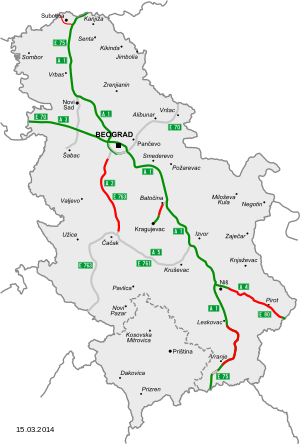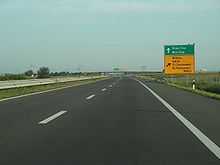Motorways in Serbia


The motorways in Serbia are called autoput (Serbian: аутопут) and the name, like its translation in most languages, simply means auto road.
The system has inherited much from the former Yugoslavia. Pay-tolls (putarine) remain in place and the speed limit is 120 km/h (75 mph).
The highways were originally marked with yellow-colour hard shoulder lines and some of these remain in place, they are however slowly being phased out and replaced with white. The motorway roadsigns maintain their green colour background, a feature shared with Switzerland, Italy, Denmark, Sweden, Greece, Lithuania and the United States as well as the other former Yugoslav republics. The roads are on the whole straight with good surfacing, and better maintained than the national roads.
Motorway A1

A1 motorway runs from the Horgoš border crossing with Hungary (for Röszke), passing Belgrade (A3 and A2 junction), Kruševac (A5 junction), Niš (A4 junction), and continues to the main border crossing with the Republic of Macedonia, Preševo-Tabanovce near Bujanovac.
The large part of this express route was built whilst Serbia was a part of the SFR Yugoslavia. Motorway A1 is part of European route E75.
Motorway A2
A2 motorway will connect Belgrade with Požega. The route passes Obrenovac and Čačak. A2 is planned to be turned into a motorway with 4 lanes by 2016.
Motorway A3
The A3 is only completed motorway in Serbia, that links Croatia with Belgrade.
Motorway A4
The A4 will be the connection of A1 to Bulgaria, part of European route E80.
Motorway A5
The A5 is a route that will connect A1 with A2. The route passes Kruševac and Kraljevo.
| ||||||||||||||